parser-type tools to help sanskrit readers.
32 views
Skip to first unread message
विश्वासो वासुकिजः (Vishvas Vasuki)
May 16, 2015, 10:21:18 AM5/16/15
to ogeti krupalu, Dr. Vamshi Krishna Ghanapathi (VKG), Varalakshmi K, sanskrit-p...@googlegroups.com, aruNaprasAda
2015-05-16 6:57 GMT-07:00 ogeti krupalu <okru...@samskritam.net>:
एवं बहवः अन्ये च बहु साहित्यं दोषभूयिष्ठं निर्मान्ति। यदि वयं तत् तथैव त्यजामः, किं गच्छता कालेन संस्कृतस्य हानिरेव न जायेत?
बाढम्। उचितमिदम्। तर्कयामि https://chrome.google.com/webstore/detail/grammarly-spell-checker-g/kbfnbcaeplbcioakkpcpgfkobkghlhen इतीव उपकरणानि लेखकेभ्यः प्रदेयानीति।
एतत्तु कालिदासस्य वा वाल्मीकेः विष्णुशर्मणो वा न करणीयमिति वयं सर्वे जानीमः।
मित्रस्य विश्वासस्य मार्गदर्शनेन मम ’जे.एन्.यू.’-कार्यदर्शनं जातं किञ्चित्। अमरकोषस्य अन्वेषणं ’विपश्चित्’ इति पदस्य समानपदानि बहूनि आनयत्। बाढम्। तेषां सन्धितन्त्रं मया किञ्चिदिव उपयुक्तम्। तत्र ’योत्स्य इति’, ’चित्तलयस्सदा’ इति उट्टङ्कनं यन्मया कृतं तस्य द्वयस्य उत्तरं तृप्तिकरं न आसीत्।
एतत् करणीयं मया इति चिन्तयन्तु भवन्तः। दर्शकः स्वस्य स्तरम् अल्पम् इति सूचितवान् इत्यपि चिन्तयत। ’सः एनं जगाद’ इति पुस्तके अस्ति कुत्रचित् मूलवाक्यम्। तत्र वाक्यविश्लेषणं कृत्वा क्रियापदं (तत्सम्बद्धं वा) -
१) ’जगाद’ इति पदं प्राप्य - ’गद’ धातोः तत् लिड्रूपम् इति ज्ञातव्यं प्रथमम्।
२) अनन्तरं धातु-डाटाबेसं दृष्ट्वा, ’गद’ धातुः तथा प्रसिद्धः न, यथा समानार्थक-’वच’-धातुः इति जानीयात् मम तन्त्रांशः (साफ्ट्वेर्)।
३) तथैव लिटः अपेक्षया क्तवतु-रूपं आरम्भे सुलभतरम् इति जानाति एव। एतज्ज्ञानं तत्र पूर्वमेव ’प्रोग्राम्’-मध्ये निविष्टं स्यात्।
४) ’वच’-धातोः ’उक्तवान्’ इति तद्रूपम् इति तन्त्रांशः पुनः जानीयात् तमेव ’डाटाबेसं’ वा अपरं वा सम्पृच्य।
’सः’ इति पदस्य अन्वेषणं कृत्वा - अन्यानि सर्वाणि पदानि एतस्य अपेक्षया विरलानि इति सञ्ज्ञाय, परिवर्तनं नावश्यकं इति जानीयात्।
’एनं’ इति पदस्य मूलरूपम् ’एनम्’ इति, तत्परं प्रातिपदिक-डाटाबेसं सम्पृच्य, तस्य प्रातिपदिकम् ’एतद्’ इति विज्ञाय, तत्र द्वितीयायां एतत् पदं द्वितीय-स्थाने अस्ति इति ज्ञात्वा, तस्य ’एतम्’ इति प्रचुरतरं प्रथमपदम् आनीय
’सः एनं जगाद’ इति वाक्यस्य ’सः एतम् उक्तवान्’ इति दर्शयेत् खलु?
प्रायशः एतत् सर्वं इदानीन्तनस्थित्यनुगुणं कष्टकरं किम्?
विचार्यताम् सहकारिभिः!
All this would require effective API calls to existing tools. (These tools don't seem to be robust due to various reasons.) Which means we require cooperation with the original authors. Most of the original authors seem to be MPhil or PhD scholars in Samskritam.
Also, all these tools might be developed on several platforms, integrating which could be a stupendous task.
Most of the software that is available seems to assume that the user is knowledgeable. For example, one tool by JNU asked me to give 'prAtipadikam' and 'lingam'. (Samskrita Bharati's learner doesn't even know what these terms are.) Then it would show the 'Sabdah'.
Our approach is to help learners. Our tools should answer the users, in place of asking them questions. While reading a book, a learner comes across a word say 'mahyam', A tool which tells him that it is 4th case of 'aham' and shows a few popular usages of this word can possibly quicken the pace of his/her learning. (It is another matter that we are catering to computer-savvy at the moment. But soon, such an app can be on mobiles opening the doors to effective Samskrit learning to one and all.)I am hoping to receive some feedback from other learned friends. Let us wait, while I use you all as a sounding board for our ideas.भवदीयः,
कृपालुः
+ अरुणप्रसादः (योऽस्मिन् विषये कार्यं कुरुते), संस्कृतसाङ्गणकाः.
युष्माकम् अत्र टिप्पणयस् सहकारो वा भवितुमर्हति।
--
Vishvas /विश्वासः
Vishvas /विश्वासः
Shreevatsa R
May 19, 2015, 4:53:37 PM5/19/15
to sanskrit-programmers, ogeti krupalu, Dr. Vamshi Krishna Ghanapathi (VKG), Varalakshmi K, aruNaprasAda
2015-05-16 7:20 GMT-07:00 विश्वासो वासुकिजः (Vishvas Vasuki) <vishvas...@gmail.com>:
एतत् करणीयं मया इति चिन्तयन्तु भवन्तः। दर्शकः स्वस्य स्तरम् अल्पम् इति सूचितवान् इत्यपि चिन्तयत। ’सः एनं जगाद’ इति पुस्तके अस्ति कुत्रचित् मूलवाक्यम्। तत्र वाक्यविश्लेषणं कृत्वा क्रियापदं (तत्सम्बद्धं वा) -
As Vishvas said, Arun is working on something related, and it shows signs of being awesome when finished.
For now, the best I'm aware of is "The Sanskrit Reader Companion" at http://sanskrit.inria.fr/DICO/reader.en.html .
You can type a sentence into it and click on Read:
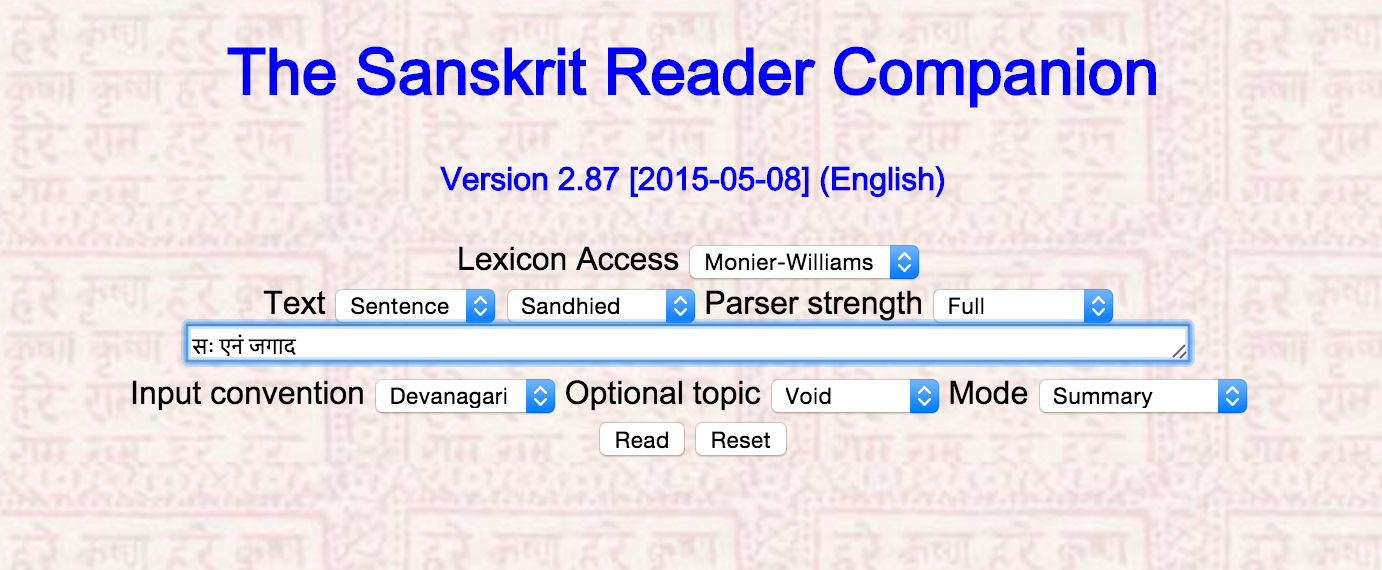
Then it shows all possible ways of "reading" that sentence:
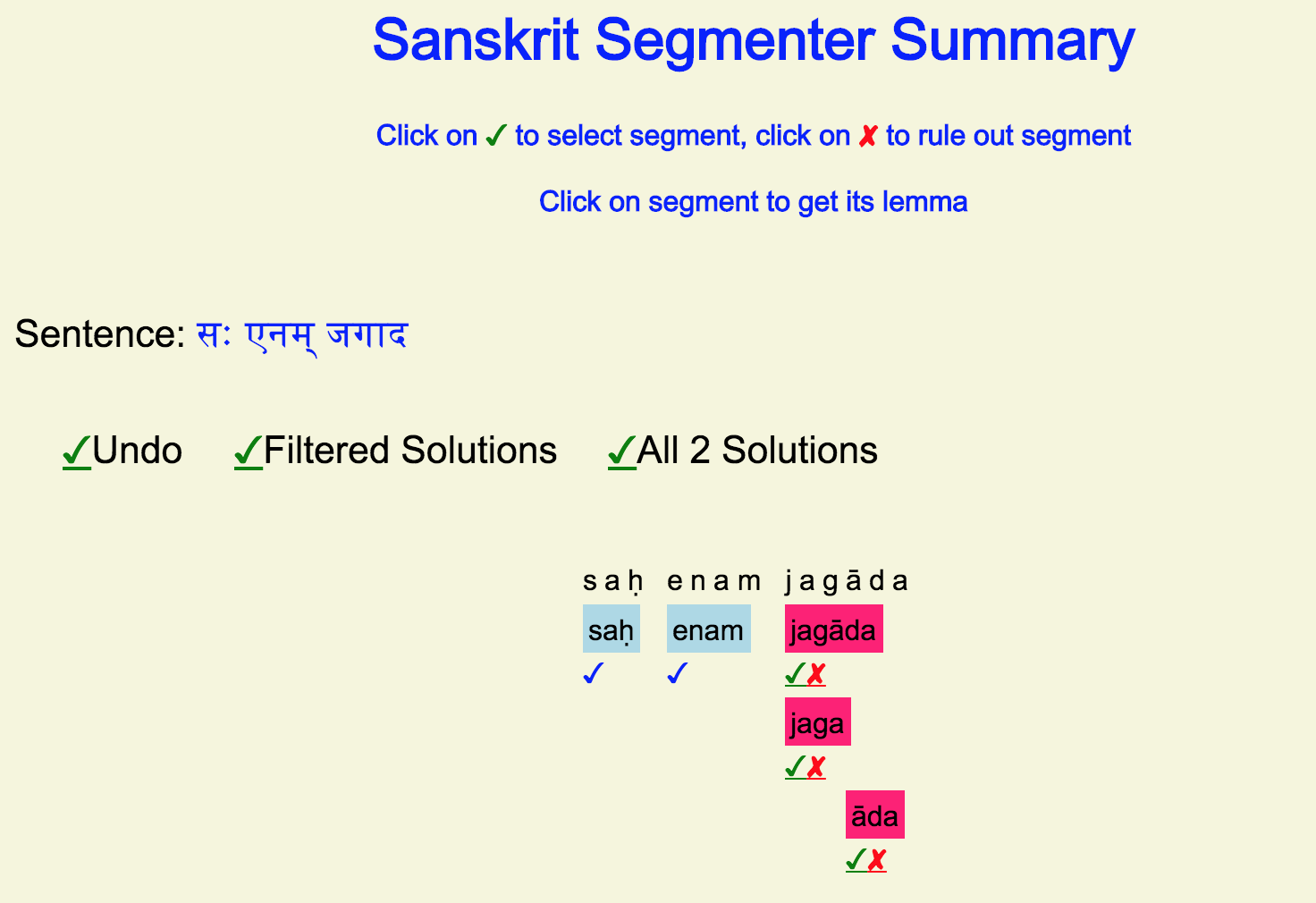
You can tick the top one (I think the options are ordered most likely to least likely) to reduce it to a single solution:
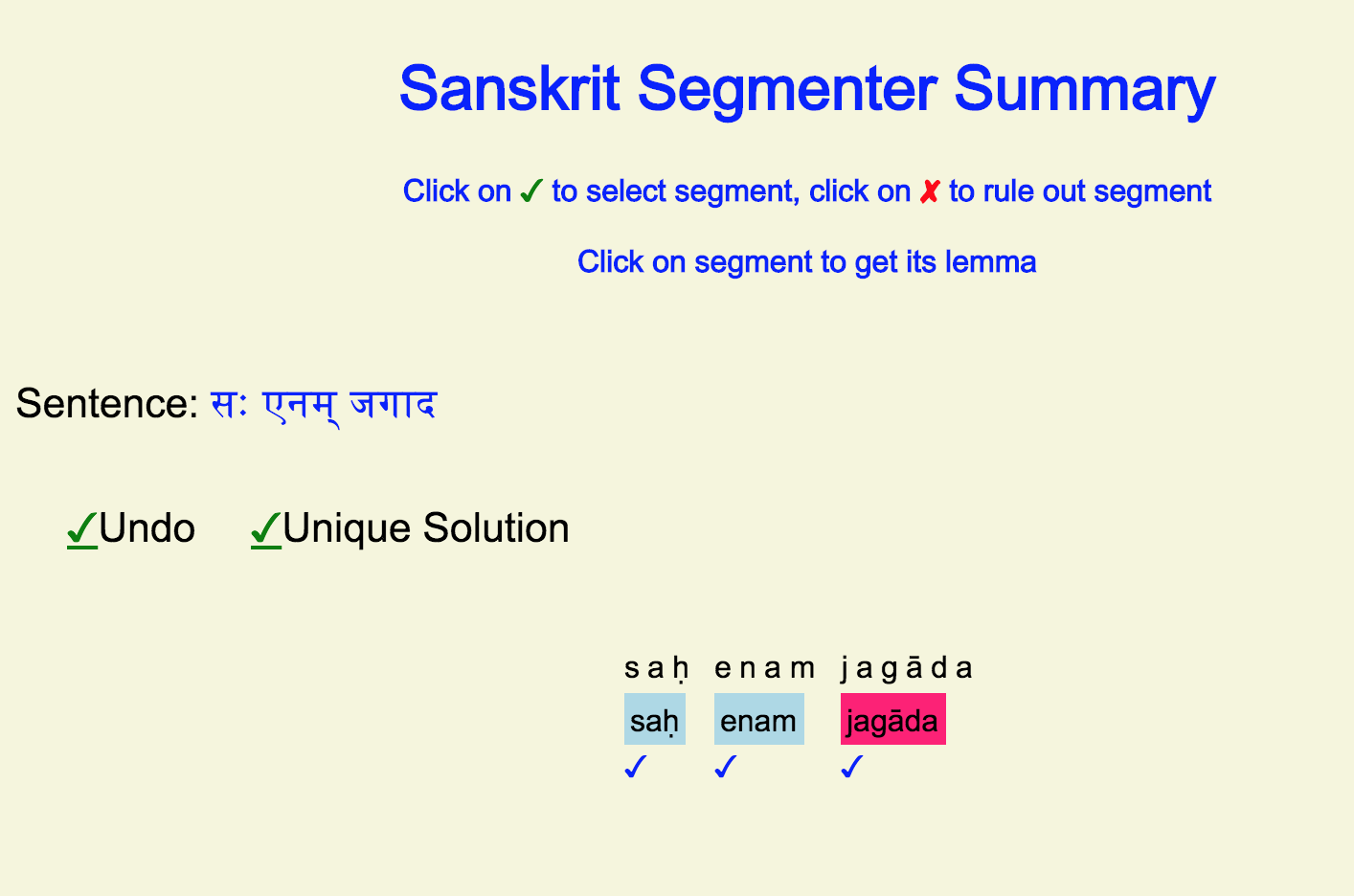
And then you can click on the words one by one to see what they are, grammatically. You can also click on the hyperlink (of the root word) to be taken to a dictionary, where you can get its meaning:

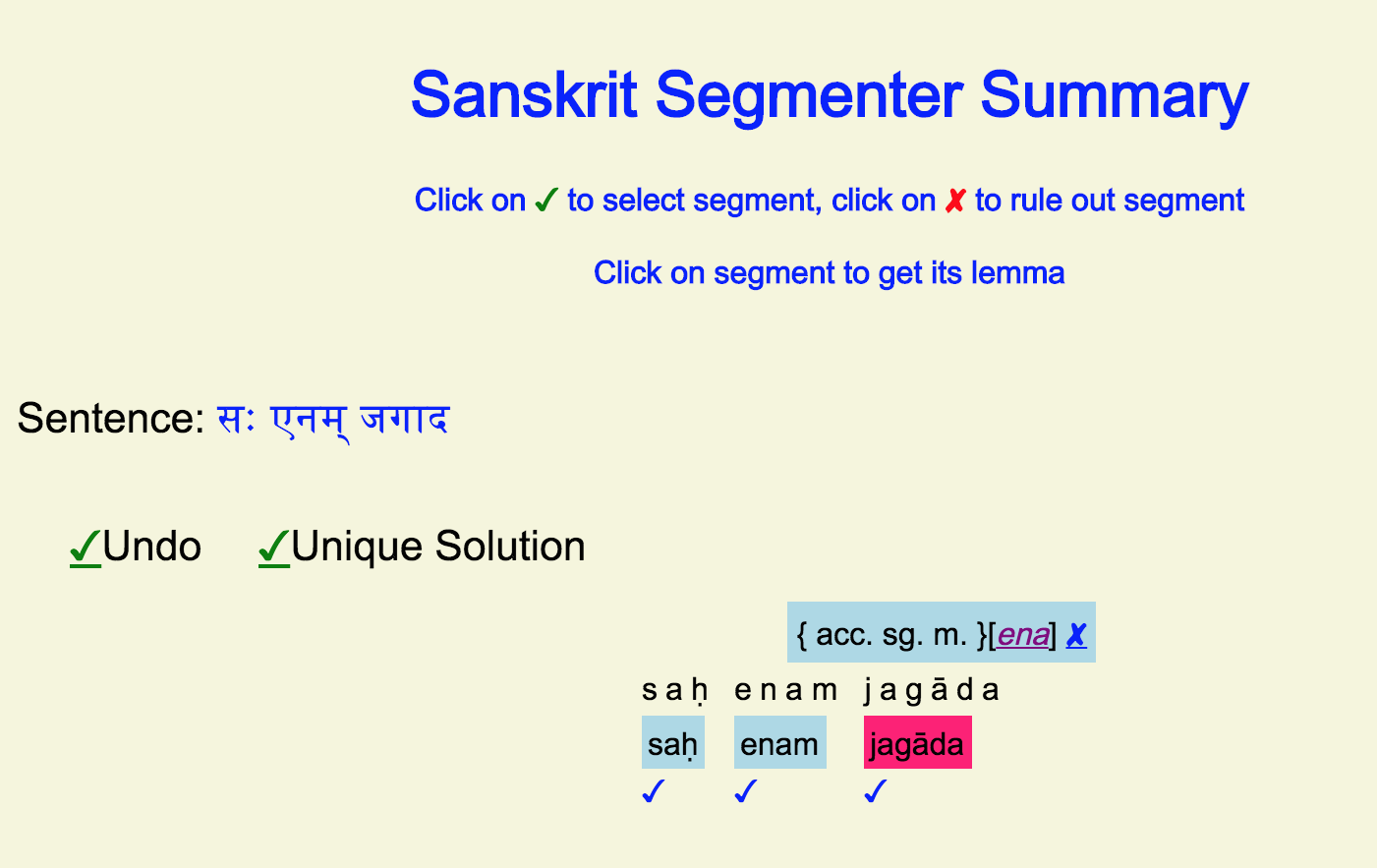
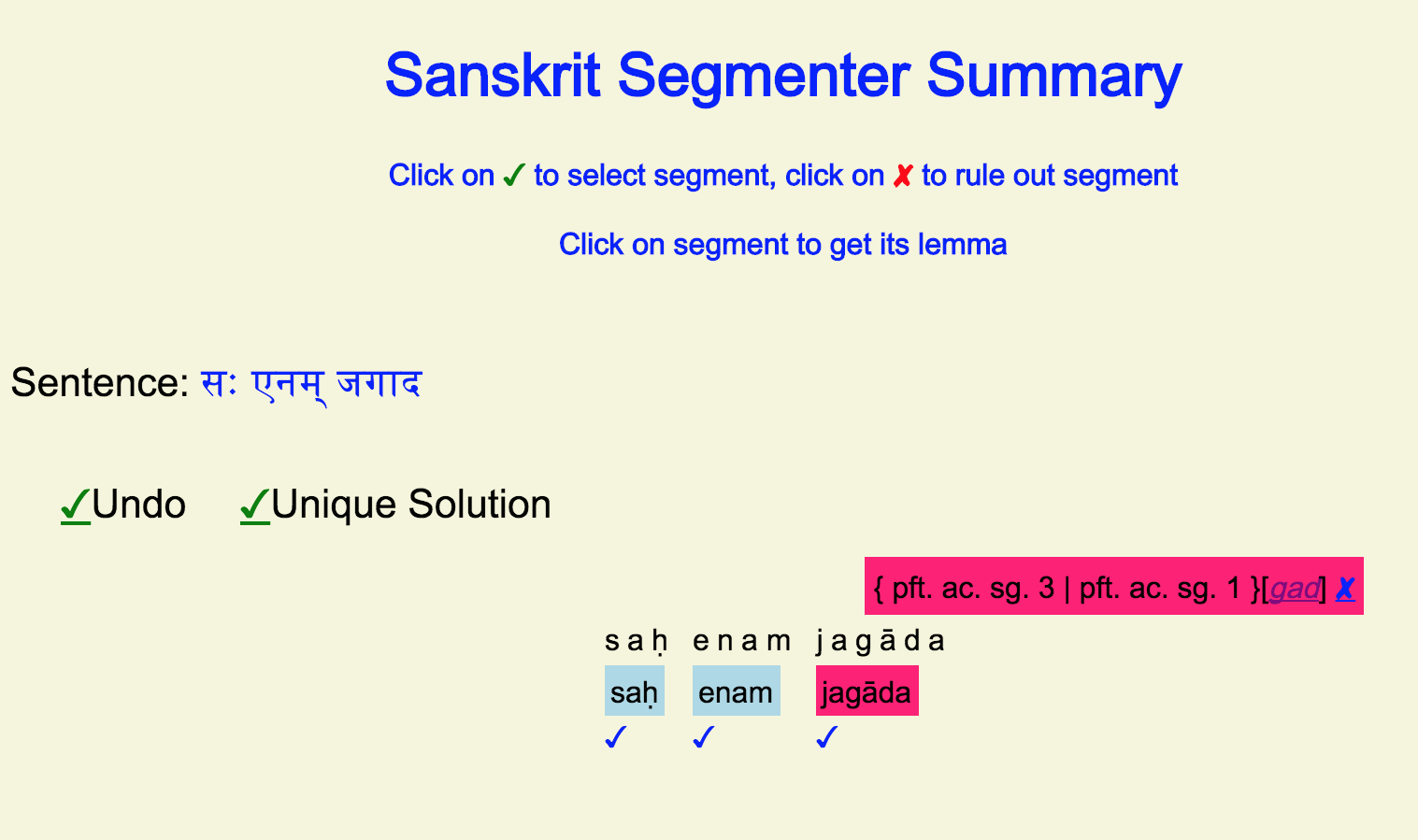
If I understand correctly, what your email describes is something with similar goals?
This interface is still not very convenient, and it requires from the student some up-front learning of grammatical terms (like what "pft. ac. sg. 3" means) -- and your suggestion of showing simpler (more common) equivalents is a wonderful idea -- but it's a sign that the problem is solvable.
Reply all
Reply to author
Forward
0 new messages
